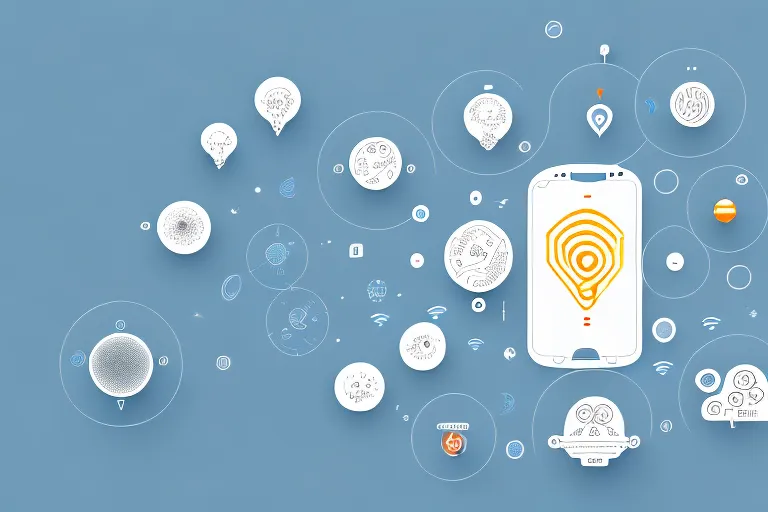Mobile communication has come a long way in recent years, with advancements in technology enabling people to connect and interact in ways that were once unimaginable. One such advancement that is shaping the future of mobile communication is the rise of micro-apps. In this article, we will delve into the world of micro-apps, understanding their core features, the role they play in enhancing user experience, the technological advancements driving their development, and what the future holds for this exciting new technology.
Understanding Micro-Apps
Before we can explore the future of mobile communication with micro-apps, it is essential to have a clear understanding of what micro-apps are. Simply put, micro-apps are lightweight applications designed to perform specific tasks or provide specific services. Unlike traditional mobile applications, which are large and complex, micro-apps are streamlined and focused, offering users a seamless and efficient experience.
Defining Micro-Apps
At their core, micro-apps are standalone applications that are built to run within a larger app or platform. They are designed with a singular purpose in mind and are often used to perform tasks such as making payments, booking appointments, or accessing specific content. These apps are developed using modern technologies and frameworks, ensuring compatibility across different devices and platforms.
Micro-apps have gained popularity due to their ability to enhance user experience and simplify complex processes. For example, imagine you are planning a trip and need to book a hotel room. Instead of downloading a full-fledged hotel booking app, you can simply use a micro-app integrated within a travel app. This micro-app will provide you with a user-friendly interface to search for hotels, view prices, and make a reservation, all without the need for additional installations or navigating through multiple screens.
Furthermore, micro-apps are designed to be modular, meaning they can be easily added or removed from the main app or platform. This flexibility allows developers to continuously improve and update specific functionalities without affecting the entire application. It also enables users to customize their app experience by adding or removing micro-apps based on their preferences and needs.
The Core Features of Micro-Apps
Micro-apps are characterized by their simplicity and efficiency. They are designed to be lightweight, consuming minimal resources and taking up little storage space on the user's device. This is particularly beneficial for users with limited storage capacity or older devices with lower processing power.
Additionally, micro-apps are highly focused, providing users with only the necessary features and functionalities to complete a specific task. This streamlined approach enhances performance and user experience, allowing users to accomplish their goals quickly and effortlessly. By eliminating unnecessary features and distractions, micro-apps prioritize simplicity and ease of use.
Another key feature of micro-apps is their ability to seamlessly integrate with other apps or platforms. They can leverage existing APIs (Application Programming Interfaces) to access data and services from different sources, enabling smooth communication and data exchange. This integration capability allows micro-apps to provide users with a unified experience, pulling information from various sources and presenting it in a cohesive manner.
Furthermore, micro-apps often incorporate personalized user interfaces, adapting to individual preferences and usage patterns. They can offer customization options, such as choosing color themes, layout styles, or even rearranging the order of displayed information. This level of personalization enhances user engagement and satisfaction, as users can tailor the micro-app to suit their specific needs and preferences.
In conclusion, micro-apps are revolutionizing the mobile app landscape by offering lightweight, focused, and efficient solutions to specific tasks or services. Their simplicity, modularity, and integration capabilities make them a powerful tool for enhancing user experience and simplifying complex processes. As technology continues to advance, we can expect micro-apps to play an increasingly significant role in shaping the future of mobile communication.
The Role of Micro-Apps in Mobile Communication
Micro-apps play a crucial role in improving mobile communication by enhancing user experience and streamlining communication processes.
Enhancing User Experience with Micro-Apps
One of the primary benefits of micro-apps is their ability to enhance user experience. By providing users with lightweight and focused applications, micro-apps ensure that users can quickly and easily perform specific tasks.
For example, imagine you are in a new city and need to book a taxi to get to your destination. Instead of downloading and navigating a full-fledged ride-sharing app, you can simply use a micro-app specifically designed for booking taxis. This micro-app would have a clean and intuitive interface, allowing you to enter your location, select a car type, and confirm your booking with just a few taps. The micro-app eliminates the need for you to navigate complex interfaces or sift through unnecessary features, making the process of booking a taxi quick and hassle-free.
Similarly, if you want to order food, instead of downloading a food delivery app with a myriad of options and menus, you can use a micro-app dedicated to food ordering. This micro-app would provide you with a curated selection of nearby restaurants, allowing you to browse their menus, customize your order, and place it effortlessly. By eliminating the clutter and focusing on the essentials, micro-apps ensure that you can complete tasks efficiently and enjoy a seamless user experience.
Moreover, micro-apps also excel at simplifying information retrieval. Let's say you want to check the weather forecast for the upcoming week. Instead of launching a comprehensive weather app with various features, you can use a micro-app that provides you with a concise and accurate weather report. This micro-app would display the current temperature, precipitation chances, and a forecast for the next few days, all in a straightforward and easy-to-understand format. With micro-apps, accessing information becomes effortless, allowing you to stay informed without any unnecessary complexities.
Streamlining Communication Processes
In addition to enhancing user experience, micro-apps also streamline communication processes. They enable users to communicate with others, access information, or perform actions without the need for multiple applications or complicated workflows.
For instance, imagine you are using a messaging platform to communicate with your colleagues. Instead of switching between different apps to schedule meetings, send files, or collaborate on documents, you can leverage micro-apps within the messaging platform itself. These micro-apps would integrate seamlessly into the interface, allowing you to perform various tasks without leaving the messaging app.
With the scheduling micro-app, you can easily check everyone's availability, propose meeting times, and send out invitations to all participants. The file-sharing micro-app enables you to browse and attach files from your device or cloud storage, eliminating the need to switch to a separate file-sharing app. Additionally, the document collaboration micro-app allows you to create, edit, and comment on documents in real-time, facilitating efficient teamwork.
By consolidating these functionalities within a single interface, micro-apps simplify communication and increase productivity. They eliminate the need for users to juggle between multiple applications, reducing the cognitive load and saving valuable time. With micro-apps, communication becomes seamless, enabling users to focus on the task at hand without unnecessary distractions.
The Technological Advancements Driving Micro-Apps
The development of micro-apps is propelled by advancements in technology, particularly cloud computing and artificial intelligence.
Micro-apps have revolutionized the way we interact with technology, offering a seamless and personalized user experience. Behind the scenes, these innovative applications are powered by cutting-edge technologies that enable their development and utilization.
The Power of Cloud Computing
Cloud computing plays a vital role in the development and utilization of micro-apps. By leveraging the power of the cloud, micro-apps can offload processing and storage requirements, ensuring optimal performance even on low-end devices.
Imagine a scenario where you want to edit a high-resolution image on your smartphone. Without cloud computing, this task would be nearly impossible due to the limited processing power and storage capacity of mobile devices. However, with micro-apps utilizing cloud infrastructure, you can effortlessly edit the image, as the heavy lifting is done in the cloud, and only the necessary data is sent back to your device.
Furthermore, cloud infrastructure enables seamless integration and synchronization between different micro-apps, creating a cohesive and interconnected ecosystem. This means that you can easily switch between micro-apps, share data, and collaborate with others, all within a unified and streamlined experience.
The Impact of Artificial Intelligence
Artificial intelligence (AI) is another technology that is driving the development of micro-apps. AI algorithms can analyze user behavior, preferences, and patterns to provide personalized experiences within micro-apps.
For example, a travel planning micro-app may use AI to recommend destinations based on a user's previous trips, budget, and interests. By understanding your preferences and travel history, the micro-app can suggest tailored itineraries, accommodations, and activities that align with your unique preferences.
Moreover, AI-powered micro-apps can adapt and learn from user interactions, constantly improving their recommendations and suggestions. This continuous learning process ensures that the micro-apps become more accurate and efficient over time, providing an increasingly personalized and valuable experience.
In addition to personalization, AI also enables advanced features within micro-apps. For instance, a fitness tracking micro-app can utilize AI to analyze your workout data and provide real-time feedback on your form, technique, and performance. This intelligent guidance enhances your fitness journey, helping you achieve your goals more effectively.
Overall, the combination of AI and micro-apps opens up a world of possibilities, where technology seamlessly adapts to our needs and preferences. These intelligent features enhance user engagement and satisfaction, making micro-apps even more valuable in our increasingly digital lives.
The Future of Micro-Apps in Mobile Communication
As we look ahead, the future of micro-apps in mobile communication appears to be incredibly promising.
Predicted Trends in Micro-App Development
Experts predict that micro-app development will continue to grow rapidly, with more industries and businesses embracing this technology. We can expect to see micro-apps catering to specific verticals, such as healthcare, finance, and education, providing tailored experiences and solutions for users in these domains. Additionally, advancements in augmented reality and virtual reality are likely to integrate with micro-apps, creating immersive and interactive experiences.
Potential Challenges and Solutions
Despite the many advantages of micro-apps, there are challenges that developers and businesses may encounter. These include ensuring security and privacy, maintaining compatibility across devices and platforms, and managing the complexity that arises from integrating multiple micro-apps. However, with careful planning, robust development practices, and the use of emerging technologies such as blockchain, these challenges can be overcome, allowing micro-apps to thrive and revolutionize mobile communication.
Conclusion: Embracing the Micro-App Revolution
In conclusion, micro-apps are revolutionizing mobile communication by offering lightweight, focused, and efficient applications that enhance user experience and streamline communication processes. With advancements in technology, such as cloud computing and artificial intelligence, driving their development, the future of micro-apps looks incredibly promising. By embracing this technology and overcoming the challenges that lie ahead, businesses and users alike can benefit from the many opportunities that micro-apps bring to the ever-evolving world of mobile communication.

